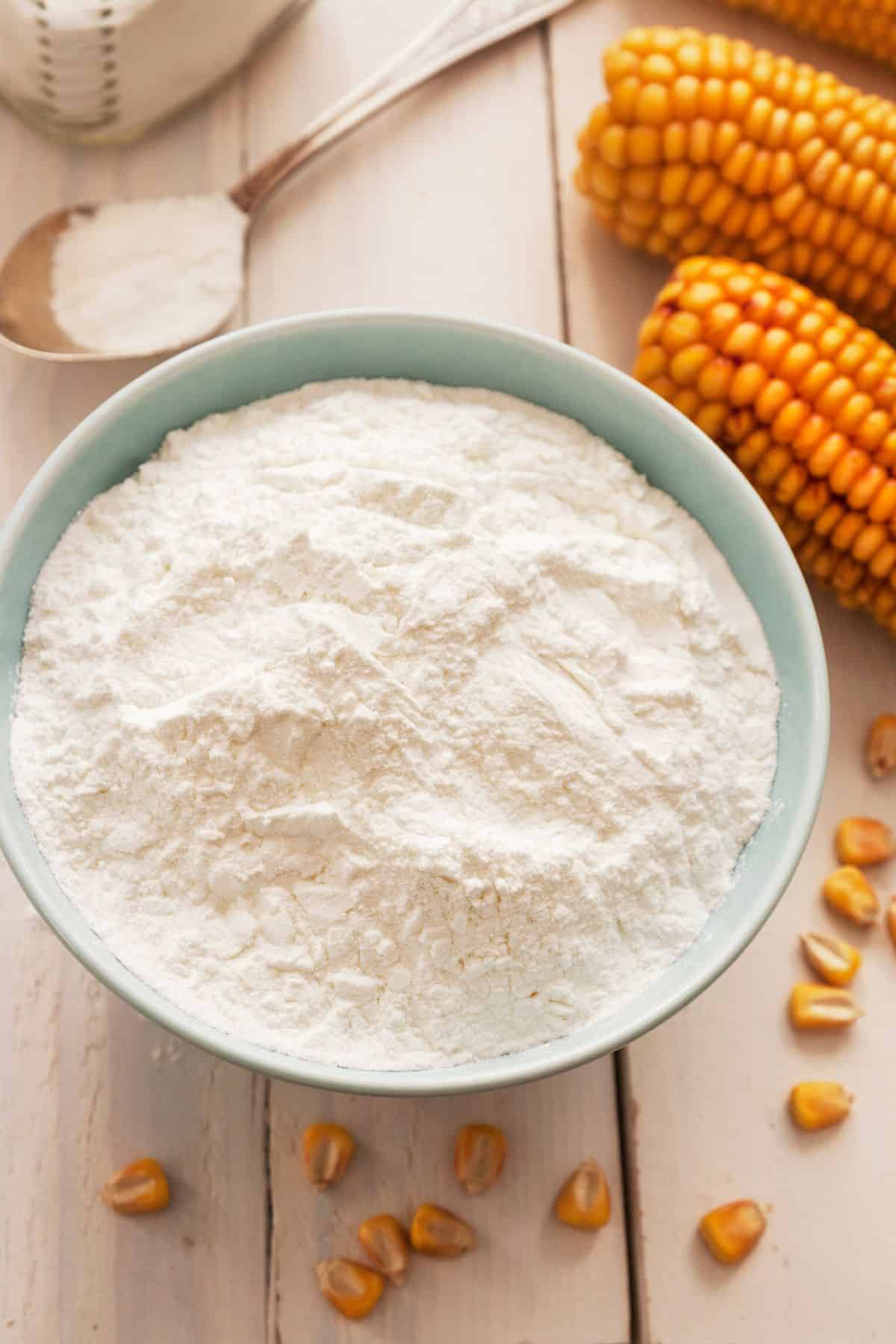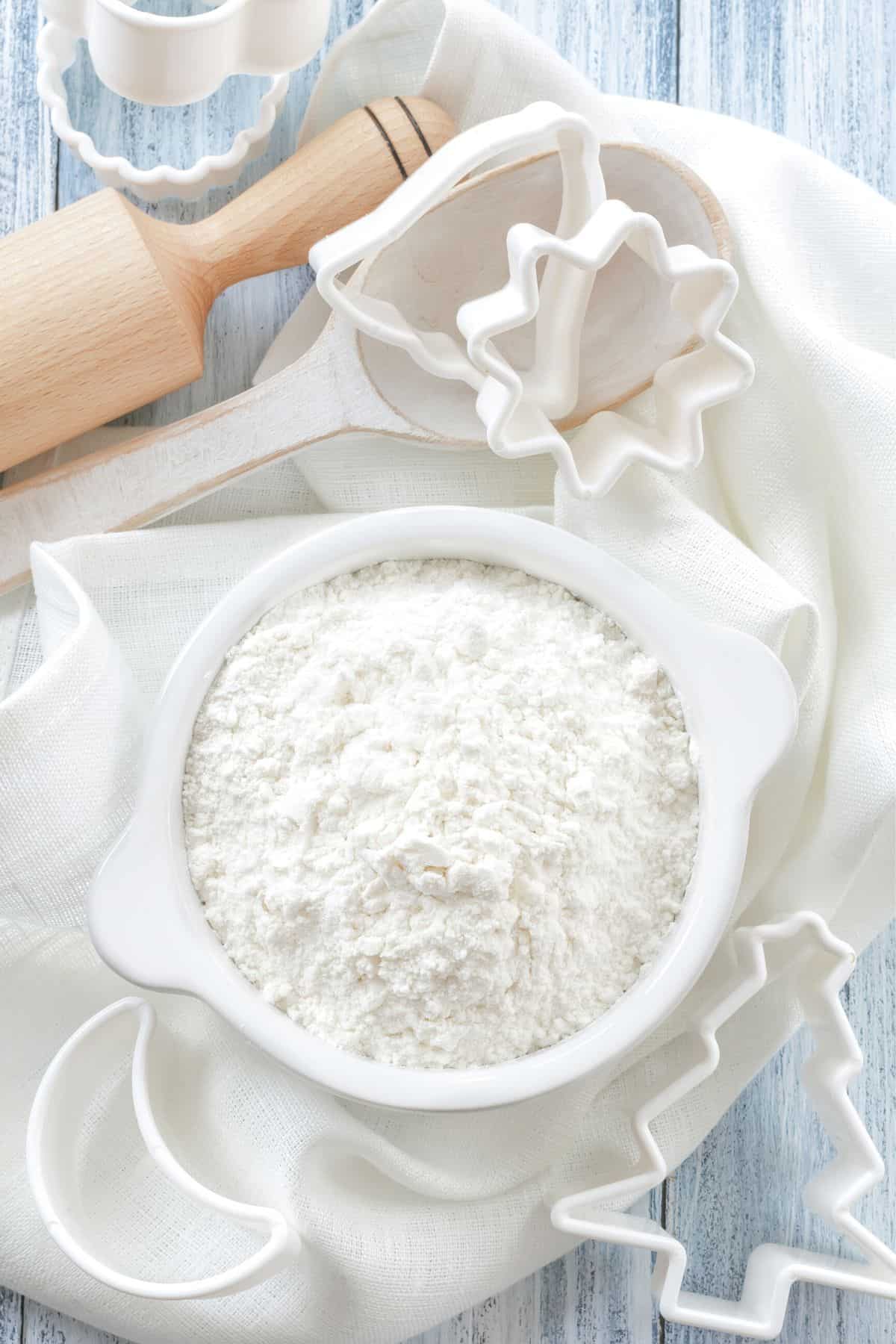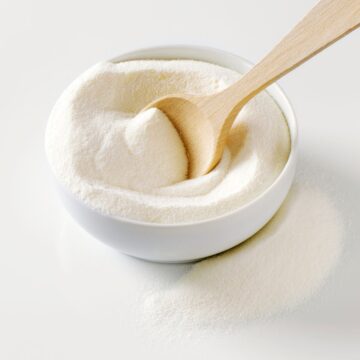If you've been searching for the best baking powder substitute for your recipes, look no further. This will be your go-to guide for the easiest and most effective ways to substitute baking powder while still getting the perfect rise in your baked goods.

Jump to:
- What is baking powder?
- What is the purpose of baking powder in a recipe?
- Baking powder vs. Baking soda
- Baking powder vs. Corn starch
- Baking powder vs. Yeast
- What can I use instead of baking powder?
- 1. Self rising flour
- 2. Baking Soda + Lemon Juice
- 3. Baking Soda + Buttermilk
- 4. Baking Soda + Yogurt
- 5. Club Soda
- 6. Baking Soda + Molasses
- 7. Whipped Egg Whites
- 8. Baking Soda + Vinegar
- 9. Baking Soda + Sour Milk
- 10. Leave it Out
- How to make homemade baking powder?
- Baking powder replacement FAQs
- Conclusions on what is the best baking powder substitute
- The BEST Baking Powder Substitute
What is baking powder?
Baking powder is a chemical leavener used in the creation of many baked goods to promote rise and fluffiness. This powder baking agent is a mixture of bicarbonate of soda (also known as baking soda), a dry acid, such as cream of tartar, and cornstarch. These ingredients work together to give recipes lift.
Examples of baking powder creating the perfect rise in baked goods include my banana bread without baking soda and my lemonade bundt cake. On the other hand, in recipes that are meant to be dense and fudgy, such as my red velvet brownies and mini brownie bites, baking powder is specifically left out of the recipe entirely.
Baking powder gives batters volume by releasing carbon dioxide gas bubbles when activated. Standard baking powder is referred to as double acting baking powder. Double acting baking powder means that it reacts twice. The first reaction is when it meets liquid in the mixing bowl and again when exposed to heat. This gives your baked goods more opportunity to rise and get a wonderfully light texture.
What is the purpose of baking powder in a recipe?
If a recipe calls for baking powder, the intention is to promote a fluffy and light texture. It can make all the difference to save you from ending up with a dense final baked product. There are many ways to create lightness and volume in a recipe, but baking powder is one of the easiest therefore if the recipe calls for baking powder, it is key that you use either baking powder or an appropriate substitute.
Baking powder vs. Baking soda
Baking powder and baking soda are both dry chemical leavening agents that are crucial to the execution of many baked goods. Both baking powder and baking soda have many similar elements, including sharing the same main ingredient(sodium bicarbonate), but they're not exactly interchangeable.
Baking powder itself contains both the alkaline and acidic elements needed to generate a reaction (rise). Simply put, baking powder is a combination of non-acidic baking soda and a dry acid, eg. cream of tartar.
On the other hand, baking powder also contains cornstarch but its purpose is to ensure the alkaline and acidic elements stay completely dry and avoid activation until they're added to a recipe. Once baking powder comes into contact with a liquid, it begins to activate and bubble.
Baking powder can be used as a baking soda replacement, but the opposite isn't quite as simple. The baking powder baking soda conversion is 3:1 but baking soda alone is not enough to give the full rise you need. Baking soda is alkaline and will not activate with just any liquid, it specifically needs to come into contact with an acid such as lemon juice, or vinegar to activate.
Even though baking soda is more potent than baking powder, without adding acid, baking soda would only create a small rise. Additionally, baking soda can also be used to neutralize the acidic flavors in recipes.
Baking powder vs. Corn starch
Cornstarch is a component of baking powder, but the difference between the two is significant. Cornstarch itself is simply a thickening agent that absorbs moisture, not a leavening agent. The presence of cornstarch in baking powder is solely to keep the baking powder inactive until it interacts with liquid.
Corn starch is often used in creams such as pastry cream as a thickening agent while baking powder is typically used in cakes to ensure a fluffy texture and nice rise.

Baking powder vs. Yeast
Baking powder and yeast are both used to make baked goods rise, but there are a lot of differences between the two. Yeast is a natural leavening agent that produces rise by the process of fermentation whereas baking powder is a synthetic leavening agent.
While it seems like yeast could be a good alternative for baking powder, it's generally not considered interchangeable. Technically, instant yeast can substitute for baking powder at a 1:1 ratio, but doing that will likely cause a poor outcome for most baked goods. Yeast can, however, work as a substitute for baking powder in some cakes and rolls. To learn more about yeast, check my yeast guide.
What can I use instead of baking powder?
If you've run out of baking powder and you need a solution quickly, you might ask yourself what to substitute for baking powder. There are many alternatives from self rising flour, baking soda + another ingredients such as vinegar, lemon juice, buttermilk, yogurt, molasses, and even club soda and whipped egg white can be a great replacement in certain cases.
It's important to think about the specifics of your recipe to determine the best baking powder alternative. For example, the best baking powder substitute for cupcakes may not be a good alternative for biscuits. It's also important to consider the amount of rise you want to achieve when determining what to use instead of baking powder.
The following list will answer the question of what can you substitute for baking powder in a wide variety of baked goods.
1. Self rising flour
Self rising flour is one of the best substitutes for baking powder because its ingredients are: all purpose flour, baking powder, and salt. You can often find it in the baking aisle next to the all purpose flour and bread flour. Self rising flour is an excellent baking powder substitute for cupcakes and cakes and since it's pantry stable, it's easy to always have on hand.
When using self rising flour, the baked good will retain its desired consistency, and its taste will be unaffected. Before you run out of baking powder, you can make your own self rising flour by combining 1 cup of all-purpose flour, 1 ½ teaspoon of baking powder and ¼ teaspoon of salt. This can be a great resource in a pinch, and a great way to plan for the future.
For more information on different flour and how to use them in baking, check out my flour guide. If you are interested in the different flour storage solutions and equipment, read my how to store flour guide.
How to use it:
To use self rising flour in place of baking powder, swap out the all purpose flour in your recipe at a 1:1 ratio and leave out any additional leavener, like baking powder or baking soda, that your recipe may call for.

2. Baking Soda + Lemon Juice
Lemon juice is an acid that, when combined with baking soda, creates the carbon dioxide gas necessary for a reaction. Lemon juice is a rich source of citric acid and has a distinctive flavor. Depending on the flavor profile of the recipe, it can be an excellent baking powder substitute instead of vinegar.
How to use it:
To replace baking powder substitute citric acid such as lemon juice and baking soda. Use 1 teaspoon lemon juice plus and ¼ teaspoon baking soda to replace 1 teaspoon baking powder.
3. Baking Soda + Buttermilk
Buttermilk is the liquid leftover from churning butter. It's a delicious ingredient in recipes like pancakes and biscuits, but it can also substitute for baking powder. Buttermilk works as a leavener because, after fermentation, it produces lactic acid.
How to use it
When used together with baking soda, buttermilk can be the acidic element necessary to activate the rise in your batter or dough. Replace ½ cup of liquid in your recipe with ½ cup of buttermilk and add ¼ teaspoon baking soda as a substitute for 1 teaspoon of baking powder.
4. Baking Soda + Yogurt
Similar to buttermilk, yogurt is a common acidic household ingredient that can replace baking powder. Not only does yogurt add moisture to your baked goods, but when combined with baking soda it can give your recipes rise. For this substitution you'll want to use plain yogurt or plain greek yogurt to avoid adding unnecessary flavors and extra sugar.
How to use it
Replace 1 teaspoon of baking powder by adding ¼ cup of plain yogurt and ¼ teaspoon of baking soda. To accommodate for the change, reduce one of the liquids in the recipe, such as milk or water by equal amounts.

5. Club Soda
Club soda contains small amounts of sodium bicarbonate. In recipes that don't call for too much leavener, club soda can be an adequate replacement. You don't even need to add baking soda. This can work for cake and waffles but isn't ideal for recipes such as cookies and bread.
How to use it
Club soda works best in recipes that are already liquid-heavy and have an acidic element. Use club soda as a baking powder alternative by replacing one of the batter's liquids with equal amounts of club soda.
6. Baking Soda + Molasses
Molasses is a byproduct of the processing of sugar cane. You might be surprised to find that the sticky substance can also be used as a substitute for baking powder. Molasses is just acidic enough that when paired with baking soda, it causes a reaction strong enough to give a small rise in baked goods. Molasses can be a great baking powder substitute for cookies, especially gingerbread cookies.
How to use it
To replace 1 teaspoon of baking powder in your recipe, use ¼ teaspoon baking soda plus ¼ cup of molasses. Be sure to reduce another liquid in the recipe to compensate for the extra moisture. Molasses is also very sweet, so you may want to consider slightly reducing the granulated sugar or brown sugar in the recipe as well.
7. Whipped Egg Whites
Whipped egg are light and airy, making them a great replacement for baking powder in recipes that need a bit of lift. Some recipes such as angel food cake can rely entirely on whipped egg whites for a fluffy and delicious cake. Whipped egg whites are a good baking powder substitute for cakes and spongey textured goods like muffins.
How to use it
You'll use the number of eggs as called for in the recipe. To whip egg whites, separate the yolks from the whites. Stir the yolks into the batter. Whip the egg whites until stiff peaks form, about 2-3 minutes, then gently fold them into the batter. The air bubbles help give the batter rise, so be careful not to burst them.

8. Baking Soda + Vinegar
Vinegar is naturally acidic, which, when paired with baking soda, makes it an excellent replacement for baking powder. The reaction between the two ingredients releases carbon dioxide gas bubbles in batters. It can be used as a leavening agent in muffins, cookies, cakes, and similar recipes. White vinegar is recommended because it has the most neutral taste. I use this baking soda and vinegar magic ingredient combination in all my cupcakes and muffin recipes and they are incredibly tender!
How to use it
To replace 1 teaspoon baking powder, combine ½ teaspoon of baking soda and ½ teaspoon vinegar. The vinegar is such a small amount it will not affect your recipe enough to force you to adjust any other ingredients.
9. Baking Soda + Sour Milk
Sour milk is similar to buttermilk, but one of the key differences is that sour milk is not fermented but rather produced by acidification. Sour milk is easily made by combining 1 cup of milk with 1 tablespoon of white vinegar. After 5 minutes, it should begin to curdle, which indicates it has become sour milk and is ready to use. This is a great replacement for waffles, cookies, and sweet quick breads.
How to use it
To replace 1 teaspoon of baking powder, mix ½ cup of sour milk and ¼ teaspoon of baking soda. For this replacement, you'll need to reduce a liquid in your recipe by ½ cup.
10. Leave it Out
While this isn't the best option, sometimes it may be the only option. If you're really in need of a sweet treat, but none of the other options will work for you, you may try your luck with simply leaving it out.
The outcome may not match the desired texture, but overall it can still work for some recipes particularly when you are not expecting a huge rise. This method works best when making crunchy cookies, baked crackers, or dense fruit bar crusts.
How to use it
Simply omit the amount of baking powder from the recipe and make no further adjustments to the recipe.
How to make homemade baking powder?
This homemade substitute for baking powder is easy to make, all you need is baking soda, cream of tartar, and cornstarch. Homemade baking powder is one of the most straightforward baking powder substitutes because it doesn't require you to alter the other ingredients in the recipe.
It's important to note that when making your own baking powder, without the presence of sodium aluminum sulfate, you are making are not making a double-acting baking powder substitute. Typically baking powders are double acting, meaning they activate twice. When making homemade baking powder, be sure to get your recipe into the oven quickly for the best results.
Replace 1 teaspoon of baking powder with the mixture of ½ teaspoon baking soda, ¼ teaspoon cream of tartar and ¼ teaspoon cornstarch. You may scale as needed and will not need to adjust any of the recipe's remaining ingredients.
Baking powder replacement FAQs
There are many substitutes for baking powder. Buttermilk, baking soda, and vinegar are just a few. Just be sure that you pay close attention to the notes on how to adjust your recipe to accommodate a substitution.
You can substitute baking powder for baking soda easily, but doing the opposite requires a bit more work. Baking soda is an excellent substitute for baking powder, but it must be paired with an acidic ingredient, such as lemon juice or vinegar to form the reaction necessary for rising.
Baked goods that don't use the required amount of baking powder are likely to become brittle, flat and may even have a poor taste. So what is a substitute for baking powder that will give you the best success? There are so many options that primarily use baking soda to help get the leavening action going.
Yes. While many of the solutions mentioned in this guide will be most helpful in a last minute situation, if you're wondering what can you substitute baking powder with to have success with every single time, the answer is homemade baking powder. This foolproof solution takes out any of the guesswork and replaces storebought baking powder with a do-it-yourself baking powder.
Store baking powder in an airtight container in a dry area such as the pantry.
Conclusions on what is the best baking powder substitute
Baking powder is one of the essential ingredients in every baker's pantry. It helps your baked goods achieve the proper lift and aids in creating the light and fluffy texture most baking recipes need. If a recipe calls for baking powder, it's done so with the intention of ensuring the success of the recipe. Baking powder is not an optional ingredient.
You'll want to find the best answer to the question of what can you use instead of baking powder. There are many baking powder substitutes that will give you similar results to actual baking powder. Not only are they easy to find, but many of them are pantry staples that you likely already have.
When deciding what to use instead of baking powder, be sure to check your pantry for baking soda, cream of tartar, and cornstarch. Making your own baking powder is the best baking powder substitute, followed by self rising flour. These options are the most similar to baking powder and will provide the best results.

The BEST Baking Powder Substitute
Best subsitute for baking soda in baking
- ½ teaspoon Baking soda
- ¼ teaspoon Cream of tartar
- ¼ teaspoon Cornstarch
Instructions
- replace 1 teaspoon baking powder with the mix of ½ teaspoon baking soda, ¼ teaspoon cream of tartar and ¼ teaspoon cornstarch


Matt
Thank you.This was helpful.
Muhammad Faisal
Very informative, I like it